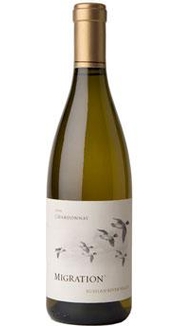Migration, Russian River Valley Chardonnay, 2008 ($30): Migration is a brand within the Duckhorn Wine Company, which embodies the Goldeneye, Paraduxx and Duckhorn wine estates. Unlike those estates, which are grounded in specific terroirs — Anderson Valley for Goldeneye and Napa Valley for the other two — Migration’s identity (picture the label with ducks in flight) is to make Chardonnay and Pinot Noir from cool climate terroirs without being tied to a specific AVA. Since its founding in 2001, Migration has made only Pinot Noir, only from Anderson Valley. With this wine, the ducks take flight to Russian River Valley, and Duckhorn Wine Company’s very first Chardonnay is the result.
Migration’s roots are at Goldeneye, which Dan and Margaret Duckhorn founded in 1990 as a Burgundy-inspired property to complement Duckhorn Vineyards’ Bordeaux-inspired varietal wines, Merlot, Cabernet Sauvignon and Sauvignon Blanc. The Goldeneye estate had three small blocks of Chardonnay vines, and the Goldeneye/ Migration winemaking team made Chardonnay from those vines experimentally for eight years before deciding that the wines did not reflect the desired style for Migration Chardonnay. The vines were grafted over to Pinot Noir in 2006.
Duckhorn Vineyards’ Bordeaux-inspired varietal wines, Merlot, Cabernet Sauvignon and Sauvignon Blanc. The Goldeneye estate had three small blocks of Chardonnay vines, and the Goldeneye/ Migration winemaking team made Chardonnay from those vines experimentally for eight years before deciding that the wines did not reflect the desired style for Migration Chardonnay. The vines were grafted over to Pinot Noir in 2006.
That desired style was similar to the style that emerged in Migration Pinot Noir — “bright, elegant, acid-driven,” according to winemaker Neil Bernardi. In tasting Goldeneye and Migration Anderson Valley Pinot Noirs side by side, that Migration style is evident: delicacy of aroma and flavor, elegance of expression, youthfulness, and fresh fruitiness driven by high acidity. In 2008, with Russian River Valley fruit – 56% of which came from the even cooler Green Valley AVA within Russian River Valley — Bernardi was able to make a Migration Chardonnay of similar style.
This Migration Chardonnay is full-bodied, of course, but it is a very gentle and finessed Chardonnay with creamy texture, well-integrated smoky oak character, and high enough acidity to give the wine an impression of both depth and length on the palate. The wine’s aromas and flavors are understated, but complex. The nose has nutty, leesy notes along with ripe apple, melon and citrus; the winery’s description includes “lemon custard” — and sure, I get that, too. In the mouth, beyond that creaminess, are flavors of peach, apple, lemon and a slight earthy note.
Winemaker Bernardi explained to me the eclectic winemaking process for this Chardonnay. It includes classic techniques such as whole cluster pressing, barrel fermentation, and some ambient yeast fermentations, as well as cultured yeast fermentation for some of the wines, malolactic fermentation for some barrels but not others, and ten months of barrel age. Only 43% of the oak was new.
With the 2009 vintage, Bernardi has continued his cool-climate quest by making small quantities of Chardonnay from Carneros, Sonoma Coast, Santa Maria Valley, Green Valley and even Anderson Valley (from the recently-acquired Rivers Rest Vineyard). If you are a lover of cool-climate Chardonnays, stay tuned.
90 Points
